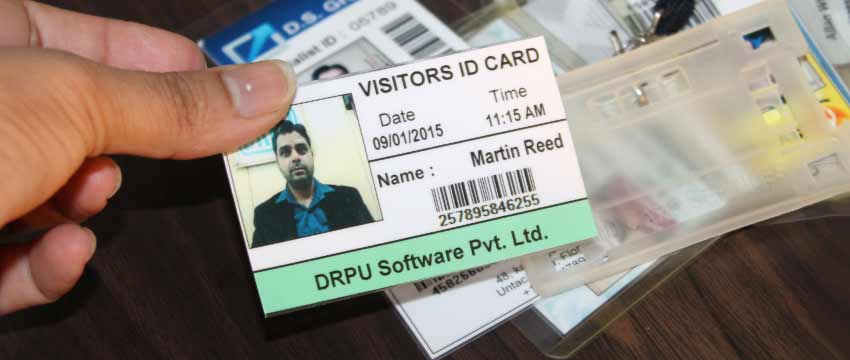Features of a Visitor ID Card
A visitor ID card, also known as a visitor badge or visitor pass, is a form of identification issued to individuals who are visiting a particular location, such as an office building, school, or event venue. The features of a visitor ID card can vary depending on the specific requirements of the organization, but here are some common elements and details typically included:
-
Personal Information:
The visitor ID card usually contains personal information about the individual visiting the premises. This includes their full name, photograph, and sometimes their signature. The purpose of including this information is to easily identify the visitor and ensure that they are authorized to be present in the designated area.
-
Expiry Date:
The ID card typically includes an expiry date, indicating the duration of the visitor's authorized access. This helps in controlling and monitoring visitor access, as expired cards should no longer grant entry. The expiration date can be printed on the card or communicated through other means such as color coding or stickers.
-
Issuing Authority:
The visitor ID card may display the name or logo of the organization or institution issuing the card. This helps establish the legitimacy of the ID card and provides contact information for verification purposes if needed.
-
Visitor's Organization:
If the visitor is representing a specific organization, the ID card may include the name or logo of their company or institution. This information helps identify the purpose or affiliation of the visitor within the premises.
-
Visitor's Designation:
In some cases, the visitor's job title or designation within their organization may be included on the ID card. This can provide additional context and help distinguish between different visitors with varying access levels or purposes.
-
Lanyard or Clip Attachment:
To ensure the ID card is clearly visible and easily displayed, it is often accompanied by a lanyard or clip attachment. This allows visitors to wear the card around their neck or attach it to their clothing for easy identification.
-
QR Codes or Barcodes:
To enhance security and streamline check-in/check-out processes, visitor ID cards may feature QR codes or barcodes. These codes can be scanned using electronic readers or mobile devices, allowing for quick verification and tracking of visitor movements.
-
Additional Security Features:
Advanced visitor ID cards may incorporate additional security measures such as holograms, watermarks, microprinting, or UV printing. These features help prevent counterfeiting and unauthorized duplication of the visitor ID cards.
-
Visitor Policy Information:
The ID card might include brief instructions or guidelines for the visitor, such as safety protocols, emergency contact information, or specific instructions related to the premises. This helps ensure that visitors are aware of and comply with the established rules and regulations.
-
Access Restrictions:
Depending on the security requirements of the facility, the visitor ID card may indicate specific access restrictions or privileges. This can be achieved through color-coded cards, designated zones, or other visual indicators. For example, some visitors may be restricted to specific areas or require an escort while others may have more extensive access permissions.
It's important to note that the specific features and design of visitor ID cards can vary significantly depending on the organization's requirements, security measures, and technological capabilities.
Customization of Visitor ID Cards
Visitor ID cards can be customized according to the specific needs and requirements of an organization. Customization allows organizations to incorporate their branding elements, security features, and any additional information they deem necessary. Here are some details on how visitor ID cards can be customized:
-
Branding: Organizations often customize visitor ID cards to reflect their brand identity. This can include adding their company or institution's logo, colors, and other visual elements. By incorporating branding, the ID card becomes a representative of the organization and reinforces its professionalism and legitimacy.
-
Design: The design of visitor ID cards can be customized to align with the organization's aesthetic preferences or existing ID card templates. This may involve choosing different layouts, font styles, and card sizes. The design can also be tailored to differentiate between different visitor categories, such as employees, contractors, or guests.
-
Variable Data: Visitor ID cards can be customized with variable data, which is specific to each individual visitor. This includes personal information like the visitor's name, photograph, and any other relevant details. Variable data allows for unique identification of visitors and helps ensure accurate record-keeping.
-
Access Levels: If an organization has varying access levels or security clearance requirements, visitor ID cards can be customized to reflect those levels. This may involve incorporating color coding or visual indicators on the ID cards to denote different access privileges or restrictions. For instance, different colors may be used to distinguish between general visitors and authorized personnel.
-
Security Features: Customization of visitor ID cards can include the incorporation of additional security features to prevent unauthorized duplication. These features may include holograms, watermarks, tamper-evident seals, UV printing, or other anti-forgery measures. The inclusion of such security features can enhance the overall integrity of the ID card and reduce the risk of fraudulent activities.
-
Technology Integration: Visitor ID cards can be customized to integrate with various technologies for enhanced security and convenience. For example, QR codes or barcodes can be printed on the ID cards, which can be scanned for quick verification and access control. In more advanced systems, proximity cards or smart cards may be used, allowing visitors to tap or swipe their cards for entry.
-
Language and Localization: In organizations with multilingual environments or international visitors, visitor ID cards can be customized to display information in multiple languages. This ensures that visitors can easily understand the instructions and details provided on the ID card.
-
Additional Information: Depending on the organization's requirements, visitor ID cards can be customized to include additional information relevant to the visitor's experience. This may include emergency contact numbers, health and safety guidelines, or specific instructions related to the premises.
Customization options for visitor ID cards may vary depending on the technology and printing capabilities available to the organization. It is important to consider the organization's security needs, visitor management processes, and any legal or regulatory requirements when determining the level of customization required for visitor ID cards.
👤 Tech Solution
📅
🕔 8 Minutes

